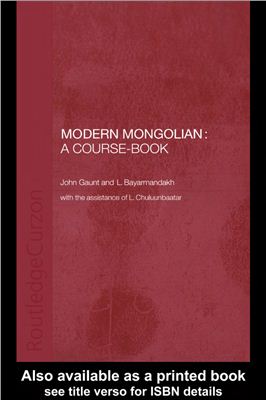Gaunt J. , Bayarmandakh L. Mode Mongolian. - Ldn. , N.Y. :
Routledge, 2004. - 257p.
The roots of this book go back to 1989. Having retued from a period of eighteen months in Mongolia, before commencing work on my PhD thesis, I was asked to do some teaching of the Mongolian language at the Mongolia and Inner Asia Studies Unit, in Cambridge. The absence of effective, English-based teaching materials at that point led me to entertain seriously the idea of writing a grammar of my own.
In the time that has followed, the contents of the book have undergone considerable revision. First, after I wrote the material, it benefited from the practised eye of Chuluunbaatar, the British Council Mongolian lector at Cambridge from 1989 to 1990.
He was able to bring to bear many years’ experience of teaching his native tongue to foreigners, including myself, and improved the Mongolian texts considerably. Bat-Ireed?i, also a Mongolian lector for the British Council, also provided considerable input and positive criticism.
At the back of the book is a vocabulary list and a key to the drills and exercises. These enable the book to be used by those studying by themselves. However, it should be said that the book was first written as teaching material, for classroom use. It has been used thus for many years, mainly by Bayarmandakh, and the experience that has given us has led to considerable revision of the texts, exercises and drills, and explanations. We would like to thank all the students who have used the book and provided feedback on it.
Our gratitude goes to Professor Caroline Humphrey, of the Mongolia and Inner Asia Studies Unit, for continued support and encouragement over the years, and especially at the end for bringing us into contact with Curzon. We would also like to thank Mngh at Mongolian TV and radio, and his colleagues, for providing the voices for the tape.
This book is not an exhaustive grammar. It is intended to give the basic building blocks of the Mongolian language so that students will have a secure foundation on which to expand their knowledge of the language through practical use. It is our intention to provide explanations that are clear, concise and understandable, without avoiding the use of some necessary grammatical terms. We hope you enjoy using the book and find it useful.
John Gaunt, Cambridge
The roots of this book go back to 1989. Having retued from a period of eighteen months in Mongolia, before commencing work on my PhD thesis, I was asked to do some teaching of the Mongolian language at the Mongolia and Inner Asia Studies Unit, in Cambridge. The absence of effective, English-based teaching materials at that point led me to entertain seriously the idea of writing a grammar of my own.
In the time that has followed, the contents of the book have undergone considerable revision. First, after I wrote the material, it benefited from the practised eye of Chuluunbaatar, the British Council Mongolian lector at Cambridge from 1989 to 1990.
He was able to bring to bear many years’ experience of teaching his native tongue to foreigners, including myself, and improved the Mongolian texts considerably. Bat-Ireed?i, also a Mongolian lector for the British Council, also provided considerable input and positive criticism.
At the back of the book is a vocabulary list and a key to the drills and exercises. These enable the book to be used by those studying by themselves. However, it should be said that the book was first written as teaching material, for classroom use. It has been used thus for many years, mainly by Bayarmandakh, and the experience that has given us has led to considerable revision of the texts, exercises and drills, and explanations. We would like to thank all the students who have used the book and provided feedback on it.
Our gratitude goes to Professor Caroline Humphrey, of the Mongolia and Inner Asia Studies Unit, for continued support and encouragement over the years, and especially at the end for bringing us into contact with Curzon. We would also like to thank Mngh at Mongolian TV and radio, and his colleagues, for providing the voices for the tape.
This book is not an exhaustive grammar. It is intended to give the basic building blocks of the Mongolian language so that students will have a secure foundation on which to expand their knowledge of the language through practical use. It is our intention to provide explanations that are clear, concise and understandable, without avoiding the use of some necessary grammatical terms. We hope you enjoy using the book and find it useful.
John Gaunt, Cambridge

